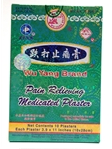One of the Most Important Hidden
Causes of Back Pain
One of the most important things that I've learned in almost 15 years of practice is this: the location of one's pain is usually not where the actual problem is. Why? Your body is designed to compensate for injured areas. The injured areas themselves are usually relatively symptom-free because they are being compensated for (given a break) by another area of the body. The pain occurs in the compensating area is because it finally gets tired of doing more work than it is normally designed to do.
You will find that in these cases direct treatment to the painful area (for example, your back) will usually only result in temporary relief. But if the problem area is discovered and appropriately addressed then the pain will usually go away-- and stay away -- even if the painful area itself is was not touched at all!
The most common problem causing back pain
The Bowstring
"The bowstring" is a concept described by Rollin Becker, D.O. (one of the greatest osteopaths ever), to explain how abnormal tension in the front of the body can cause reciprocal tension in the back and the spine (eventually causing back pain), just as pulling on a bowstring puts additional tension on the bow. Releasing the abnormal tension in the front of the body results in a spontaneous release of the unnecessary tension in the back, in the same way that releasing a pulled bowstring lets the bow "relax". Then, usually over several days, the associated pain dissipates as the irritated tissues heal.
This abnormal tension can come from many causes. ALL auto accidents -- no matter how small -- are suspect (whiplash is not the only thing that happens during an accident). Taking a direct impact to the front of your body or getting the wind knocked out of you are also common causes. Abdominal surgery is another important cause.
 This idea is not well known in the health field and it will be difficult to find someone familiar with treating bowstring injuries to help you (if you are unable to see me). One way is to find a body worker skilled in myofascial release and ask them if they will release the areas listed below: (bring them a copy of this article or the book mentioned below)
This idea is not well known in the health field and it will be difficult to find someone familiar with treating bowstring injuries to help you (if you are unable to see me). One way is to find a body worker skilled in myofascial release and ask them if they will release the areas listed below: (bring them a copy of this article or the book mentioned below)- The linea alba on the abdomen
- The respiratory diaphragm
- The scalenes and the anterior cervical fascia (in the supraclavicular fossa)
- The submandiublar fascia and digastric muscle (the soft tissue in the underside of the jaw)
- The masseter (chewing muscles)
This is only a short list meant to try to cover many different scenarios. The book Ligamentous Articular Strain goes into far more detail than I could here and contains an entire section on the bowstring concept.
By far, I find that most of the back pain I am successfully able to eliminate comes from abnormal tension found in the front of the body. The discovery of this hidden cause has contributed more than anything else to simple and permanent resolution of patients' back pain in my clinic.
Example Case Study:
A number of years ago a woman sought me out for relief of a bad case of sciatica, which is a nerve pain running through the buttock and, in her case, down the back of the leg. It is often caused by pressure on the nerve where it comes out of the spine or where it runs through the back and buttock muscles. This woman's sciatica was resisting treatment and the most significant events in her history were a number of c-sections, which of course are major abdominal surgeries. I treated only the scar tissue on the lower abdomen using myofascial release techniques and touched nothing else. The sciatica almost completely resolved after the first visit and completely resolve after the second visit. When this same woman saw me 4 or 5 years later for something else, she reported that the pain had never come back since that second treatment. Releasing the scar tissue on the lower abdomen had allowed the abdominal muscles to function more normally, releasing the pressure on the back that was affecting the sciatic nerve.
If you are experiencing back pain that is not resolving with traditional approaches, consider this approach.







